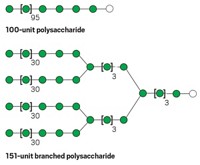Advertisement
Grab your lab coat. Let's get started
Welcome!
Welcome!
Create an account below to get 6 C&EN articles per month, receive newsletters and more - all free.
It seems this is your first time logging in online. Please enter the following information to continue.
As an ACS member you automatically get access to this site. All we need is few more details to create your reading experience.
Not you? Sign in with a different account.
Not you? Sign in with a different account.
ERROR 1
ERROR 1
ERROR 2
ERROR 2
ERROR 2
ERROR 2
ERROR 2
Password and Confirm password must match.
If you have an ACS member number, please enter it here so we can link this account to your membership. (optional)
ERROR 2
ACS values your privacy. By submitting your information, you are gaining access to C&EN and subscribing to our weekly newsletter. We use the information you provide to make your reading experience better, and we will never sell your data to third party members.
Green Chemistry
Chemists synthesize largest, most complex polysaccharide to date
Arabinogalactan contains 92 sugars and is a component of tuberculosis bacterium’s cell wall
by Stu Borman, C&EN Washington
April 11, 2017

A record in carbohydrate synthesis has been broken: Researchers have synthesized a glycan nearly twice as large as, and more complex than, any made before.
The polysaccharide, called an arabinogalactan, contains 92 sugars and is an essential cell-wall component in Mycobacterium tuberculosis, the bacterium that causes tuberculosis, and other mycobacteria. The tuberculosis drug ethambutol works by blocking the polysaccharide’s biosynthesis.
“It is important that somebody showed this can be done,” says glycan expert Peter H. Seeberger of the Max Planck Institute of Colloids & Interfaces, who was not involved in the synthesis. “It illustrates what is possible with traditional methods. Chemists can now think of what one might do with such large carbohydrates.”
Xin-Shan Ye of Peking University, whose group carried out the total synthesis, says he believes the work could lead to novel tuberculosis vaccines and a better understanding of the bacterium’s mechanism of cell-wall biosynthesis (Nat. Commun. 2017, DOI: 10.1038/ncomms14851).
Natural glycans, which are oligosaccharides or polysaccharides, adopt a multiplicity of structural forms in living organisms. They exist in only small quantities and are hard to isolate, making it difficult to characterize them, evaluate them as drug targets, and use them in carbohydrate vaccines and other applications.
To overcome these limitations, researchers synthesize the glycans in the laboratory, often up to a few tens of sugars in length. Synthesizing larger glycans is tough work: They are structurally complex, they have specific regio- and stereochemistry, the syntheses include multiple protecting-group manipulations, and reaction intermediates are difficult to purify.
Chemists have wrestled with this complex chemistry over the years. In 1993, a RIKEN group including Tomoya Ogawa and Yukishige Ito synthesized a 25-sugar glycan—a feat that held the size record for many years. Todd L. Lowary of the University of Alberta and coworkers made a 22-unit fragment of the mycobacterial arabinogalactan a decade later. Since then, carbohydrate chemists have synthesized glycans in the 30- and 40-unit range. And Seeberger and coworkers just submitted a paper reporting the automated carbohydrate synthesis of a linear 50-sugar oligosaccharide—the largest single glycan ever created in one go, without combining smaller fragments.
But the mycobacterial arabinogalactan not only has nearly twice as many sugar units as Seeberger’s glycan but is also branched and more complex. The researchers assembled it by using preactivation-based one-pot glycosylation, an efficient synthetic method they developed previously. They optimized the method to rapidly synthesize five-, six-, and seven-unit glycans, each in a single pot. They used coupling reactions to combine sets of those short glycans into one 30-sugar galactan and two identical 31-sugar arabinans. The team then joined the three fragments into the 92-sugar arabinogalactan. One graduate student and several undergraduates accomplished the synthesis in two-and-a-half years.
Lowary says his group has recently been trying to make glycans with close to 100 sugars. “We’re nowhere near that, but now Ye and coworkers have been able to do it,” he says. “Considering the sheer size and complexity of the arabinogalactan, the efficient way they’ve put it together is tremendous. It shows how far you can push the envelope, and it will be a catalyst for future work in large-glycan synthesis.”
CORRECTION: The arabinogalactan structure in this story was revised on Nov. 30, 2017, to correct the number of sugars in the arabinan units.





Join the conversation
Contact the reporter
Submit a Letter to the Editor for publication
Engage with us on Twitter